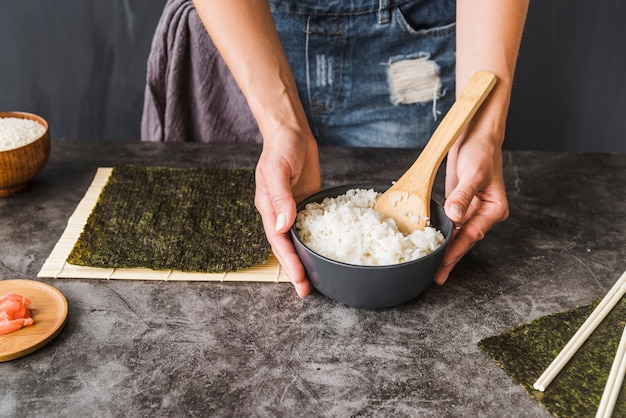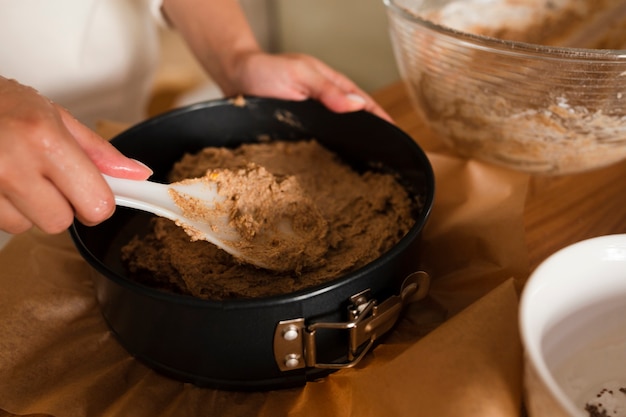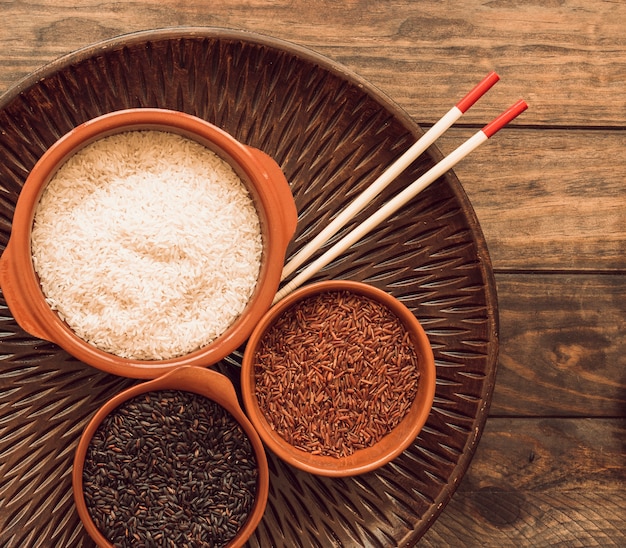Let's be honest, brown rice has a bit of a reputation. It can be a tad intimidating to cook, with tales of mushy or rock-hard results lurking in every kitchen. But here's the truth: achieving perfect brown rice is easier than you might think – especially if you have a trusty rice cooker by your side.
I used to be a brown rice newbie, struggling to get the texture right and ending up with a sticky mess or a pile of hard grains. Then, I discovered the magic of the rice cooker. My life changed, and I haven't looked back. Now, I can whip up fluffy, flavorful brown rice every single time, without the worry of burnt pots or endless stovetop monitoring.
This article is my love letter to the rice cooker and a guide to unlocking the secrets of perfect brown rice. I'll share my tried-and-true tips, tricks, and even a few personal stories about my brown rice journey.
(Part 1) choosing the right rice: The Foundation for Deliciousness

A World of Brown Rice: Finding Your Perfect Match
Firstly, let's talk about rice. There's a whole universe out there, and it can be a little overwhelming if you're not familiar with the different types. But don't worry, it's all about finding your perfect match.
My go-to is long-grain brown rice. It cooks up light and fluffy, with a lovely chewiness and a subtle nutty flavor. It's incredibly versatile and pairs well with everything from savory stir-fries to creamy sauces. However, don't be afraid to experiment!
- short-grain brown rice: This type produces a stickier rice, perfect for sushi or rice bowls.
- medium-grain brown rice: It's a happy medium between long and short grain, often used in rice pilafs and casseroles.
- wild rice: This unique grain has a distinct earthy flavor and a firmer texture. It's often used in salads or as a side dish for roasted meats.
I remember the first time I tried wild rice. I was intrigued by its earthy flavor and slightly crunchy texture. It made me realize that brown rice wasn't just a boring side dish, but a gateway to a world of culinary possibilities.
Reading the Packaging: Your Guide to Success
Once you've chosen your rice, take a moment to read the packaging. It's a treasure trove of information, including cooking times, water ratios, and even nutritional facts. You'll often find suggestions for different cooking methods, and some brands even offer specific recipes using their rice.
For example, I recently discovered a brand of brown rice that recommended a slightly longer cooking time for a fluffier texture. I was skeptical at first, but I gave it a try and was pleasantly surprised. It was a revelation! Now, I'm always checking the packaging for those little nuggets of wisdom.
Washing the Rice: A Ritual for Perfection
Now comes the essential step: washing the rice. This isn't just a fancy culinary ritual; it actually makes a difference in the final texture and taste. Think of it as giving your rice a refreshing spa treatment.
Why wash rice? It helps remove excess starch, which can make your rice sticky and clumpy. You'll end up with a lighter, fluffier, and more flavorful result.
Simply place your rice in a fine-mesh sieve and run cold water over it until the water runs clear. Don't be shy with the water; a thorough rinse is key. It might seem like a small detail, but trust me, it's worth the extra effort.
(Part 2) Your Kitchen Hero: The Rice Cooker

Rice Cooker 101: A Quick Guide to Features and Types
Let's talk about the star of the show: your rice cooker. It's a simple yet brilliant invention that takes the guesswork out of cooking rice. No more burnt pots, no more frantic stirring, just perfectly cooked rice, every time.
There are two main types of rice cookers:
- Basic rice cookers: These are simple and affordable, typically featuring a single button for "white rice" or "brown rice". They're ideal for anyone who wants a fuss-free way to cook rice.
- Multi-cookers: These are more versatile and feature multiple cooking settings, allowing you to cook a variety of dishes like soups, stews, and even cakes.
I started with a basic rice cooker and was blown away by its simplicity. It's still my go-to for everyday rice cooking. But as my love for rice grew, I decided to upgrade to a multi-cooker. It's a bit of an investment, but it's been worth every penny. I love the freedom to experiment with different recipes and cuisines.
Understanding Your Rice Cooker: Knowing the Parts
Here's a quick overview of the essential parts of your rice cooker:
| Part | Function |
|---|---|
| Inner pot | The non-stick pot where the rice is cooked. |
| Heating element | Located at the bottom of the rice cooker, it heats the inner pot. |
| Control panel | Features buttons for different cooking settings like "white rice", "brown rice", "steaming", and "keep warm". |
| Lid | Seals the rice cooker during cooking and traps steam. |
Mastering the Settings: Finding the "Brown Rice" Button
The most important thing to look for in a rice cooker is a "brown rice" setting. This setting typically uses a longer cooking time and a slightly higher temperature to ensure the rice is cooked perfectly.
Don't be tempted to use the "white rice" setting for brown rice. It won't cook evenly, and you might end up with a soggy mess.
(Part 3) The Ultimate Recipe: Perfect Brown Rice in Your Rice Cooker

Gathering Your Ingredients: Simple and Essential
For perfectly cooked brown rice, you only need a handful of ingredients:
- 1 cup brown rice (rinsed, of course!)
- 2 cups water (or slightly more, depending on your rice cooker and your preference)
- Pinch of salt (optional)
Step-by-Step Instructions: A Simple Guide to Success
Here's how to make perfect brown rice in your rice cooker:
- Rinse your brown rice thoroughly under cold water until the water runs clear.
- Pour the rinsed rice into the inner pot of your rice cooker.
- Add the water and a pinch of salt, if desired. I usually add a pinch of salt to enhance the flavor, but it's completely optional.
- Close the lid of the rice cooker and select the "brown rice" setting.
- Let the rice cooker do its magic! The cooking time will vary depending on your model and the type of rice you're using. It's usually between 40-60 minutes.
- Once the rice is cooked, the rice cooker will automatically switch to a "keep warm" setting. This is a great feature to keep your rice warm and delicious for hours.
- Let the rice sit for a few minutes before fluffing it with a fork. This step is crucial for achieving the perfect texture.
Tips and Tricks: Enhancing Your Brown Rice Experience
Here are a few extra tips to take your brown rice to the next level:
- Use a measuring cup specifically for rice: This ensures you're using the correct amount of rice for your rice cooker, preventing overfilling or under-filling.
- Don't overfill the inner pot: Leave some space for the rice to expand while cooking.
- Experiment with different water ratios: Some people prefer their brown rice a little drier, while others like it a bit wetter. Adjust the water ratio to your liking.
- Add other ingredients to your rice cooker: Get creative! You can add vegetables, herbs, or spices to your rice while it cooks. For example, I love adding a chopped onion and a sprig of rosemary to my brown rice for a savory and aromatic flavor.
(Part 4) FAQs: Answering Your Questions
Now, let's address some common questions about brown rice and rice cookers.
1. Can I Cook Other Grains in My Rice Cooker?
Absolutely! Your rice cooker is a versatile tool. You can cook quinoa, barley, oats, and even couscous in it. Just check your rice cooker's manual for specific instructions and settings for different grains.
I recently discovered the joy of cooking quinoa in my rice cooker. It's so convenient and the result is perfectly fluffy quinoa every time. It's now my go-to grain for salads and bowls.
2. How Long Can I Keep Cooked Brown Rice in the Fridge?
Cooked brown rice can be stored in the fridge for up to 3-4 days in an airtight container. It's a great way to have a healthy and convenient meal prepped for busy weeknights.
3. Can I Reheat Brown Rice in the Microwave?
Yes, you can reheat brown rice in the microwave. Just add a splash of water to the container and microwave for 1-2 minutes, or until heated through.
I often reheat leftover brown rice for a quick and easy breakfast with a fried egg on top. It's a simple yet satisfying meal that gets me going in the morning.
4. How Do I Clean My Rice Cooker?
Cleaning your rice cooker is a breeze! Simply wash the inner pot with warm soapy water after each use. Avoid using harsh abrasives, as they can damage the non-stick coating. If there's any burnt-on food, let it soak in warm water for a few minutes before scrubbing it off.
5. Can I Use My Rice Cooker to Make Other Dishes?
Many modern rice cookers have multiple functions and can be used to make soups, stews, and even cakes! Check your rice cooker's manual for specific instructions and recipes.
(Part 5) The Art of Fluffing: The Final Touch for Perfect Texture
After your rice cooker has finished cooking, don't rush to dig in! Let the rice sit for a few minutes to allow the steam to redistribute. Then, gently fluff it with a fork. This ensures a light, fluffy texture and prevents the rice from becoming sticky or clumpy.
Think of fluffing as a gentle massage for your rice, encouraging the grains to separate and release their fluffy potential. It's a simple yet crucial step for achieving that perfect rice texture.
(Part 6) The Versatility of Brown Rice: Beyond the Basics
Brown rice is incredibly versatile, and it can be enjoyed in countless ways. It's not just a boring side dish; it's a blank canvas for culinary creativity.
Brown Rice as a Side Dish:
It's a perfect accompaniment to any meal, from roasted vegetables and grilled meats to fish and curries. Its subtle flavor and hearty texture make it a welcome addition to any plate.
brown rice salads:
Toss cooked brown rice with your favorite vegetables, herbs, and dressing for a healthy and satisfying salad. The combination of textures and flavors creates a delightful symphony for your taste buds.
brown rice bowls:
Create your own customizable bowl with brown rice as the base. Add toppings like grilled chicken, avocado, roasted sweet potatoes, edamame, and a drizzle of sriracha. The possibilities are endless!
Brown Rice in Desserts:
Don't be afraid to get creative! Brown rice can be used in desserts like rice pudding or even rice flour pancakes. It adds a subtle nutty flavor and a unique texture to sweet treats.
(Part 7) Brown Rice: A Nutritious Powerhouse
Beyond its deliciousness, brown rice is a nutritional powerhouse, packed with fiber, magnesium, and manganese. It's gluten-free, making it a great option for those with gluten sensitivities. It's also a good source of complex carbohydrates, providing sustained energy throughout the day.
So, you're not just enjoying a delicious meal, you're nourishing your body with essential nutrients.
(Part 8) Conclusion: Embracing the Perfect Brown Rice Journey
There you have it: your guide to achieving perfect brown rice every time. It might seem like a simple task, but the rewards are great. You'll enjoy a delicious, nutritious, and versatile grain that's easy to prepare.
Remember, the key is to choose the right rice, understand your rice cooker, and follow these simple steps. It might take a few tries to find your perfect ratio and cooking time, but the journey is worth it. And once you've mastered the art of perfect brown rice, the world of culinary possibilities will be yours to explore. So, go forth and embrace the goodness of brown rice!
Everyone is watching

How to Cook Frozen Lobster Tails Perfectly: A Step-by-Step Guide
RecipesLobster. Just the word conjures up images of lavish meals, special occasions, and a taste of luxury. But let's...

Pigs in a Blanket Cooking Time: How Long to Bake for Perfect Results
RecipesAh, pigs in a blanket. Just the name conjures up images of those delightful little parcels of crispy pastry en...

Pork Fillet Cooking Time: How Long to Cook It Perfectly
RecipesPork fillet, or tenderloin as it's sometimes called, is a real favourite in our house. It's so versatile, and...

The Ultimate Guide to Cooking Delicious Frankfurters
RecipesLet's face it, we all love a good frankfurter. It's a classic, simple, and always satisfying. But let's be rea...

Wolf Meat Recipes: A Guide to Cooking Wild Game
RecipesLet's be honest, you don't see wolf meat at your local butcher shop every day. It's a bit of a wild card, but ...
